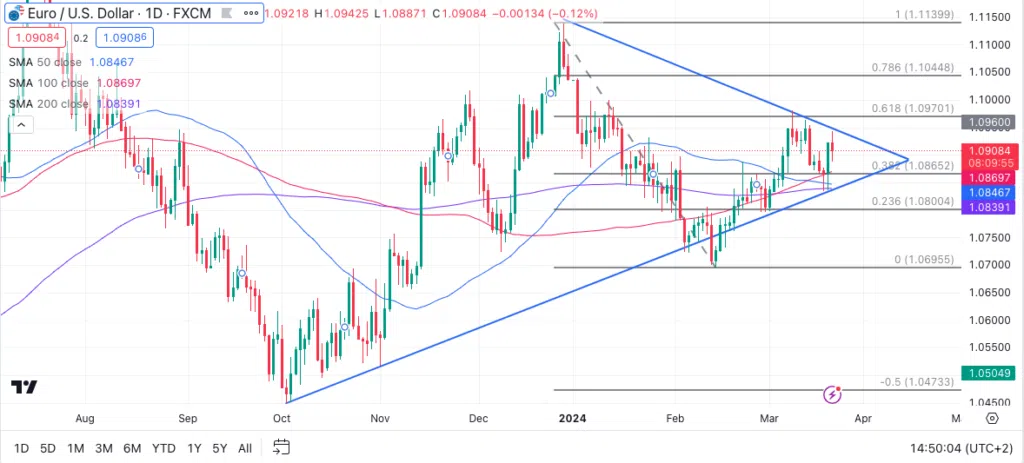-
Best Forex Brokers
Our top-rated Forex brokers
-
Brokers for Beginners
Start trading here
-
ECN Brokers
Trade with Direct Market Access
-
Forex Demo Accounts
Learn to trade with no risk
-
Lowest Spread Brokers
Raw spreads & low commissions
-
Islamic Account Brokers
Best accounts for Muslim traders
-
Market Maker Brokers
Fixed spreads & instant execution
-
MetaTrader 4 Brokers
Top MT4 brokers in Philippines
-
MetaTrader 5 Brokers
Top MT5 brokers in Philippines
-
cTrader Brokers
Top cTrader brokers in Philippines
-
All Trading Platforms
Find a platform that works for you
-
Copytrading Brokers
Copy professional traders
-
Forex Trading Apps
Trade on the go from your phone
In a week packed full of interest rate decisions from central banks (including surprise moves from the Swiss and Turkish central banks today), the most important was yesterday’s decision by the FOMC of the US Federal Reserve (Fed).
As expected, the Fed opted to keep interest rates on hold and stuck to its December projection for three rate cuts over the course of 2024, the so-called “dot plot.” According to the CME FedWatch Tool, the probability of the Fed leaving the policy rate unchanged in June declined to 25% from 40% before the Fed decision, weakening the USD.
But what really piled pressure on the dollar was Fed Chairman Jay Powell’s comments after the decision. He said:
“As labour market tightness has eased and progress on inflation has continued . . . we believe that our policy rate is likely at its peak for this tightening cycle, and that if the economy evolves broadly as expected, it will probably be appropriate to begin dialling back policy restraint at some point this year…”
In a visibly relaxed mood, Powell insinuated that recent signs of sticky inflation were seasonal rather than systemic, and clearly indicated that the Fed was on track to lower interest rates substantially over the course of the year without causing economic harm. “The economy is performing well,” Powell said. He suggested that headline inflation of 2.4 per cent was edging towards the Fed’s 2 per cent target. “We continue to make good progress on bringing inflation down.”
The Fed also raised its projections for economic growth in 2024, up from 1.4% to 2.1%, signalling that the US economy’s much-discussed “soft landing” was in sight. It’s rare to have strong economic growth, decreasing inflation and a simultaneous decline in interest rates.
The optimistic outlook buoyed the markets. The S&P 500 and Nasdaq Composite closed at record highs on Wednesday. Government bond prices rose as yields fell and the EUR/USD spiked as the USD, as represented by the DXY index, declined.
Market optimism continued into Thursday. The Eurozone composite purchasing managers’ index, which measures business activity, rose to a nine-month high of 49.9, up from 49.2 a month earlier.
Although upbeat PMI data from the US might limit the USD’s losses, the improving risk mood could make it difficult for the currency to stage a consistent rebound. As Mark Dow, author of the Behavioural Macro blog, said: “It’s not about Fed liquidity, it’s about risk appetite, and we can create all the liquidity we need without the Fed.”
Technical Analysis EUR/USD
Having challenged trendline resistance early on Thursday at 1.0950, the EUR/USD succumbed to the resistance and stabilised at the 1.0900 level, dropping below that to 1.0887 earlier in the day. This downward slump occurred after the release of the mixed Eurozone PMI data which showed lower-than-expected Manufacturing PMI data in Germany. Again, we see the pair trading in a range, with no real direction.

EUR/USD Daily Chart on TradingView, prepared by Alison Heyerdahl
Should the price push higher, it will likely meet trendline resistance at the 1.0950 level, with the March 13th level of 1.0960 as its next focus. Above that, the March high of 1.0981 will be the next resistance level to push through before it meets the 1.1000 psychological handle.
Any downside moves could see the 100-day SMA (pink) provide support at around 1.0870 and lower than that, where the 50-day SMA (blue) and 200-day-SMA (purple) converge with the uptrend line at around 1.0840.
































